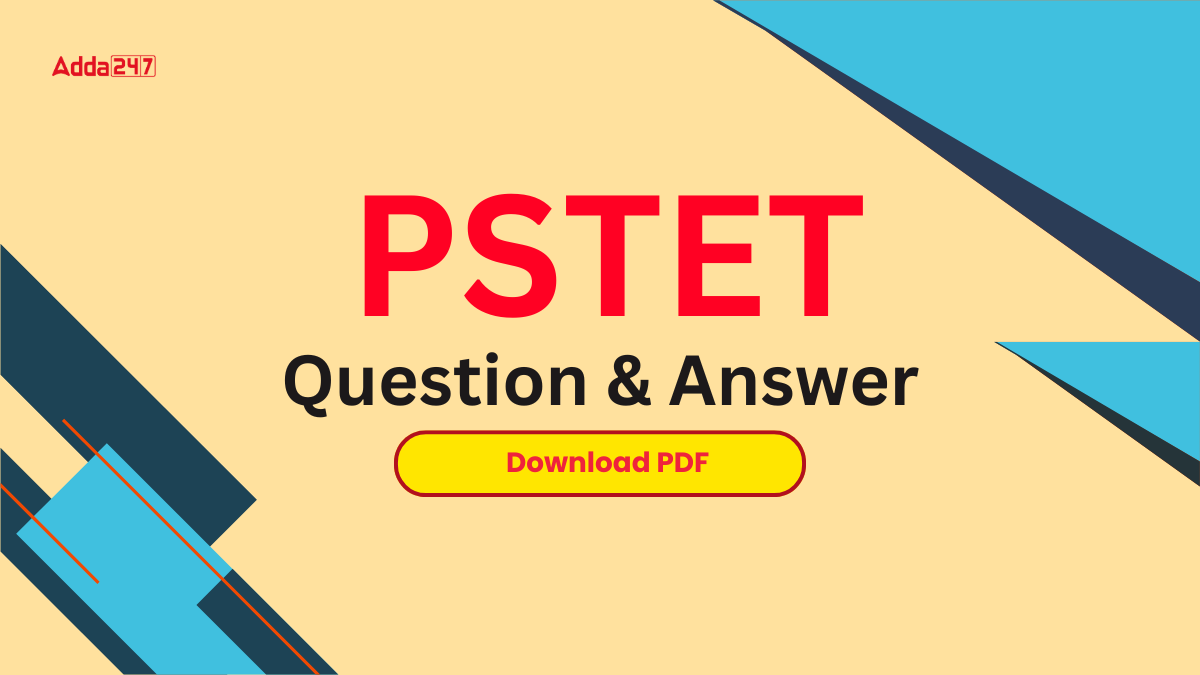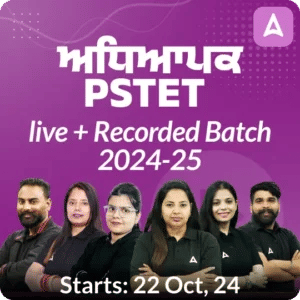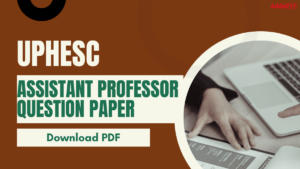Table of Contents
The PSTET 2024 (Punjab State Teacher Eligibility Test) is a state-level exam conducted by the Punjab School Education Board (PSEB). It is scheduled for 1 December 2024, and is essential for candidates seeking eligibility to teach in primary (Classes I to V) and upper primary (Classes VI to VIII) schools across Punjab. The exam consists of two papers: Paper I for candidates aspiring to teach at the primary level and Paper II for those targeting upper primary teaching positions. Candidates should stay updated on the application process and other important details to ensure they are well-prepared for the exam.
PSTET EVS Question: Overview
The PSTET 2024 (Punjab State Teacher Eligibility Test) will be conducted by the Punjab School Education Board (PSEB) at the state level. Held once a year, the exam will be in a conventional pen and paper format, lasting two and a half hours. The total marks for the exam are 150, with 30 marks dedicated to the EVS section, and candidates will need to answer 150 questions, including 30 questions from the EVS section. The exam will be available in bilingual language options (English and Hindi). The primary purpose of the PSTET 2024 is to determine the eligibility of teaching aspirants for positions in Primary (Classes I to V) and Upper Primary (Classes VI to VIII) sections in Government Schools in Punjab.
| PSTET Exam Date 2024 | |
| Exam Name | Punjab State Teacher Eligibility Test (PSTET) |
| Conducting Body | Punjab School Education Board (PSEB) |
| Exam Level | State-level |
| Exam Frequency | Once in a year |
| Exam Mode | Conventional (pen and paper) |
| Exam Duration | Two and a half hours |
| Total Marks | 150 Marks (30 Marks dedicated to EVS Section) |
| Total Questions | 150 Questions (30 Questions dedicated to EVS Section) |
| Language | Bilingual ( English and Hindi) |
| Exam Purpose | To offer eligibility to teaching aspirants for Primary (classes I to V) and Upper Primary (classes VI to VIII) Sections in Government Schools in Punjab |
PSTET EVS Questions and Answers
Q1. A person observed the lifestyle of the people of rural areas of a State and expressed his view as under “The living is very simple. People grow eatables such as tapioca and coconut in their courtyards and they enjoy eating the food prepared using these eatables.”
This State must be
(a) Kerala
(b) Odisha
(c) Assam
(d) Telangana
Q2. Consider the following statements about the “Jhoom Farming” practised in the forests of Mizoram.
- After cutting one crop the land is left as it is and nothing is grown there for some years.
- The bamboo or weeds which grow on that land are cut and burnt.
- The land is then ploughed deeply before sowing the seeds.
- Chemical fertilizers and pesticides are used as per need.
- In one farm different types of crops like maize, rice, chillies and vegetables are grown.
The correct statements are
(a) A, B and C
(b) B, C and D
(c) C, D and E
(d) A, B and E
Q3. Solve the following riddle.
“Small and round like a pearl
I am black when I am fine ground or coarse
A sharp and spicy taste is mine
Whether it is salty or sweet
I am added as a special treat.
Think and tell me who am I?
Tell me quickly who am I?”
The solution is?
(a) Pepper
(b) Cardamom
(c) Mustard
(d) Clove
Q4. Which one of the following can find his female from many kilometres away by her smell?
(a) Eagle
(b) Silkworm
(c) Mosquito
(d) Butterfly
Q5. Select from the following cities where most of the people enjoy drinking of hot Kahwa with almonds and cardamom.
(a) Shillong
(b) Mysore
(c) Hyderabad
(d) Srinagar
Q6. A person visited most of the rural areas of a State and gave the following description about the structure of houses in which the people live. “Because of heavy rains the houses are made almost 3 m to 3.5 m (10-12 feet) above the ground on the strong bamboo pillars. People use ladder to enter their houses and at night the ladder is removed. The insides of the houses are made of wood and the roofs are sloping.” This State must be
(a) Himachal Pradesh
(b) Mizoram
(c) Jharkhand
(d) Assam
Q7. In the tourist guide of Delhi a map is given. On this map at its one corner it is mentioned. Scale 1 cm = 990 metres.
If on this map this measured distance between any two places is 21.2 cm, the actual distance between the two places is (close to)
(a) 22 kilometres
(b) 21 kilometres
(c) 20 kilometres
(d) 19 kilometres
Q8. Select from the following a pair disease spread/caused due to mosquitoes.
(a) Malaria and Typhoid
(b) Chikungunya and Dengue
(c) Cholera and Typhoid
(d) Dengue and Cholera
Q9. Select from the following a pair of birds having excellent sight and see things distinctly four times as far as we can.
(a) Crow and Kite
(b) Eagle and Vulture
(c) Sunbird and Eagle
(d) Crow and Vulture
Q10. The State in which the word ‘Torang’ is meant for jungle is
(a) Mizoram
(b) Jharkhand
(c) Arunachal Pradesh
(d) Chhattisgarh
Q11. The house of a student is at X and his school is at Y and there is no straight path between X and Y. So, in order to reach the school, the student goes first to A which is 60 m due South of X, then to B which is 60 m due East of A, then to C which is 50 m due South of B and finally reaches his school which is 60 m due East of C. With respect to the school the correct direction of his house is
(a) South-East
(b) South-West
(c) North-East
(d) North-West
Q12. A train departed from Bhiwandi Road Railway Station on 22nd November 2022 at 20:30 hours and reached Nagercoil railway station on 24th November, 2022 at 03:00 hours. If the distance covered by the train between these two railway stations is 1877 kilometres, the average speed of the train is (close to)
(a) 58 km/h
(b) 59 km/h
(c) 60 km/h
(d) 62 km/h
Q13. Three territorial States of Madhya Pradesh are
(a) Gujarat, Rajasthan, Maharashtra
(b) Uttar Pradesh, Bihar, Chhattisgarh
(c) Maharashtra, Chhattisgarh, Jharkhand
(d) Gujarat, Telangana, Odisha
Q14. A group of States having Coast on the Arabian Sea are
(a) Tamil Nadu, Odisha, Andhra Pradesh
(b) Kerala, Karnataka, Maharashtra
(c) Gujarat, Maharashtra, Odisha
(d) Gujarat, Kerala, Telangana
Q15. Select from the following a pair comprising one State and one Union Territory of our country.
(a) Lakshadweep and Puducherry
(b) Chandigarh and Delhi
(c) Nagaland and Ladakh
(4) Manipur and Meghalaya
Solutions for PSTET EVS Questions
S1. Ans.(a)
Sol. The correct answer is Kerala.
The observation mentioned in the statement is about the lifestyle of people in rural areas of a state. The statement mentions that people in rural areas grow eatables such as tapioca and coconut in their courtyards and enjoy eating food prepared using these eatables. Kerala is a state known for its agriculture and coconut cultivation, making it a possible answer to the question.
S2. And.(d)
Sol. The correct answer is A, B and E.
Jhoom farming is also known as slash-and-burn agriculture. It is a traditional method of farming practised in the hilly regions of Northeast India. The land is cleared by cutting and burning the vegetation, and the ash is used as a natural fertilizer. This method of farming is sustainable if done in moderation, but overuse can lead to deforestation and soil degradation.
- Statement (a) is correct as leaving the land fallow for a few years allows the soil to regenerate and regain its fertility.
- Statement (b) is correct as cutting and burning the vegetation is a common practice in Jhoom farming to clear the land.
- Statement (c) is correct as ploughing the land deeply helps in breaking up the soil and preparing it for sowing.
- Statement (d) is incorrect as Jhoom farming relies on natural fertilizers like ash and compost, and pesticides are not used.
- Statement (e) is correct as Jhoom farming involves growing multiple crops on the same land to maximize its productivity.
S3. Ans.(a)
Sol. The correct answer is Pepper.
The riddle describes black pepper, which is small and round like a pearl and has a sharp and spicy taste. Pepper can be ground finely or coarsely, which changes its appearance to black. It is often added as a special seasoning to both salty and sweet dishes. It is a commonly used spice in many cuisines around the world and is derived from the berries of the Piper nigrum plant.
- Cardamom is a spice with a warm, sweet flavour that is often used in Indian and Middle Eastern cuisine.
- Mustard is a condiment made from the seeds of the mustard plant and has a sharp, tangy flavour.
- Clove, is a spice with a strong, sweet, and slightly bitter taste that is often used in baking and cooking.
S4. And.(b)
Sol. The correct answer is Silkworm.
Silkworm can find their mate from a distance of several kilometres through pheromones.
Pheromones are chemical substances produced by organisms to communicate with each other, especially for mating purposes.
S5. Ans.(d)
Sol. The correct answer is Srinagar.
- Srinagar is located in the northern region of India and is known for its traditional Kashmiri Kahwa tea which is made with saffron, cardamom, and almonds.
- Shillong is a city located in the northeast region of India and is known for its tea plantations, but the locals do not have a specific preference for Kahwa tea.
- Mysore is a city located in the southern region of India and is known for its filter coffee, not Kahwa tea.
- Hyderabad is a city located in the central region of India and is known for its Irani chai and biryani, not Kahwa tea.
S6. And.(d)
Sol. The correct answer is Assam.
The state being described in the statement is Assam, as it is known for its heavy rainfall and the use of bamboo in construction. The fact that the houses are elevated on strong bamboo pillars is a common practice in Assam due to the frequent flooding in the region. The use of ladders to enter the houses and removing them at night is also a safety measure against wild animals like tigers and elephants. The use of wood for the interiors and sloping roofs is also typical of traditional Assamese architecture.
S7. Ans.(b)
Sol. The correct answer is 21 Kilometeres
- Scale is a ratio that shows the relationship between a distance on a map and the corresponding actual distance on the ground.
- In this case, the scale is 1 cm = 990 meters, meaning that for every 1 centimetre on the map, the actual distance is 990 meters.
- To find the actual distance between two places on the map, we need to multiply the measured distance by the scale factor.
- The scale factor in this case is 990 meters/1 cm = 99000 meters/1 inch.
- The measured distance between the two places on the map is 21.2 cm. To find the actual distance, we need to multiply 21.2 cm by the scale factor of 99000 meters/1 inch.
- 21.2 cm x 99000 meters/1 inch = 2,095,200 meters.
- Converting meters to kilometers, we get 2,095,200 meters / 1000 = 2095.2 kilometers.
- Rounding off to the nearest kilometer, the actual distance between the two places is 2095 kilometers, which is closest to option 2 (21 kilometers).
S8. And.(b)
Sol. The correct answer is Chikungunya and Dengue.
Chikungunya and Dengue:-
- These both are vector-borne diseases caused by the Aedes mosquito.
- Symptoms of Chikungunya include fever, joint pain, headache, and muscle pain, while Dengue can cause high fever, severe headache, joint and muscle pain, and in severe cases, hemorrhagic fever or shock syndrome.
- Both diseases are commonly found in tropical and subtropical regions, including parts of Asia, Africa, and the Americas.
- Prevention methods for both diseases include mosquito control measures such as removing standing water, using mosquito nets, and wearing protective clothing.
S9. Ans.(b)
Sol. The correct answer is Eagle and Vulture.
Eagles and vultures have excellent sight and can see things distinctly four times as far as humans can. This ability is due to their large eyes and high concentration of photoreceptor cells in their retinas.
S10. And.(b)
Sol. The correct answer is Jharkhand.
‘Torang:-
- It is used for jungle in the local language of the state.
- ‘Torang’ is a word from the Ho language, which is spoken by the Ho tribe in Jharkhand.
Jharkhand: –
- It is a state in eastern India, which was formed in the year 2000 after being separated from Bihar.
- The state is known for its rich mineral resources, forests, and tribal culture.
S11. Ans.(d)
Sol. The correct answer is North-West
From the provided information, the student’s journey can be represented as follows:
X (Start) 60 m
A → 60 m
B ↓ 50 m
C → 60 m
Y (School)
This describes a path that forms a rectangle with the sides being 60m by 50m.
→ Placement of the points suggests that point X is 60 meters north of point A, which is directly above point B.
→ Point B is to the east of point A and is directly to the right of point C.
→ Then point C is to the south of point B and directly below point Y.
→ Lastly, point Y is to the east of point C and is the endpoint.
→ In this journey from X to Y, the student adds 60 meters to the south, 60 meters to the east, 50 meters to the south, and 60 meters to the east.
→ This totals to 120 meters to the south and 120 meters to the east from his initial position X.
→ This means that the student’s house (X) would be to the Northwest of the school (Y).
S12. And.(d)
Sol. The correct answer is 62 km/h
From 20:30 on November 22nd to 20:30 on November 23rd = 24 hours
From 20:30 on November 23rd to 03:00 on November 24th = 6.5 hours
Adding those together you get 24 hours + 6.5 hours = 30.5 hours (in decimal hours).
The formula to calculate average speed is distance/time. If we plug in our given values of:
Distance = 1877 kilometers
Time = 30.5 hours 1877 km / 30.5 hours = 61.5462 km/h
So, the average speed of the train is approximately 62 km/h.
S13. Ans.(a)
Sol. The correct answer is Gujarat, Rajasthan, Maharashtra.
Gujarat shares its border with Madhya Pradesh in the west, Rajasthan in the northwest, and Maharashtra in the south. These three states are located at a distance from Madhya Pradesh.
S14. And.(b)
Sol. The correct answer is Kerala, Karnataka, Maharashtra.
Kerala: –
It is often referred to as ‘God’s Own Country,’ is located on the southwestern coast of India. It’s known for its scenic beauty, plentiful coconut groves, backwaters, and rich spices.
Karnataka: –
It is located on the Western coast as well. It is known for its significant contribution to Indian culture, history, and technology.
Maharashtra: –
It is a state in the western peninsular region of India, known for being an economic powerhouse and the home of Bollywood.
It has several bustling cities like Mumbai, the financial hub of India and the nation’s largest city.
S15. Ans.(c)
Sol. The correct answer is Nagaland and Ladakh
Nagaland: –
- Nagaland is a state situated in Northeast India. It shares its border with the Indian states of Assam, Arunachal Pradesh, and Manipur. It also has an international border with Myanmar to the east. The capital city of Nagaland is Kohima, and the largest city is Dimapur.
- The official language is English, which is widely spoken and used for conducting administrative, political, and judicial work. There are also over a dozen tribal languages spoken across the state.
- The state is famous for its festivals. Hornbill Festival, one of the most celebrated, showcases the rich cultural heritage of the tribes.
Ladakh: –
- Location: Ladakh is a region administered by India as a union territory. It is located in the northernmost part of the Indian subcontinent in the larger region of Kashmir, between the Kunlun Mountain range in the north and the main Great Himalayas to the south.
- The capital city of Ladakh is Leh. Another major town in the region is Kargil.
- Ladakh is popular for its Buddhist monasteries or gompas, which are a symbol of the region’s rich Buddhist heritage. Some of the famous monasteries include Hemis, Thiksey, Diskit, and Alchi Monastery.
Download the PSTET Environment Studies Questions and Answers PDF
Click the direct link to download the detailed PSTET Environment Studies Question and Answer PDF. This essential resource contains 30 PSTET EVS questions and answers, covering both content and pedagogy, to help candidates strengthen their preparation.
Download PSTET EVS Questions and Answers PDF
| PSTET 2024 Important Links | |
| PSTET 2024 | PSTET Syllabus 2024 |
| PSTET Previous year Question Papers | PSTET Exam Date 2024 |
| PSTET Eligibility Criteria 2024 | PSTET Preparation Tips 2024 |
| PSTET Admit Card 2024 | – |




 UPHESC Assistant Professor Question Pape...
UPHESC Assistant Professor Question Pape...
 Is the CSIR NET Exam Tough? Know the Dif...
Is the CSIR NET Exam Tough? Know the Dif...
 Tips & Strategies to Prepare for CSI...
Tips & Strategies to Prepare for CSI...














